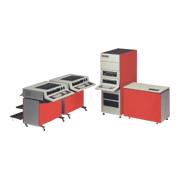This office computer from Mitsubishi Electric was announced in 1974. It used a packaging system based on LSI and MSI components -- employing, for example, a microprocessor (bit-slice TTL MSI) for the arithmetic section and MOS LSI for the main memory. It used "AOS" multiprocessing operating system for basic software.
The microprogramming system was used for the central processing unit (CPU), and, combined with the use of LSI and MSI, this made the CPU extremely simple compared to the hard-wired logic system. This made it possible to achieve greater compactness, density, reliability and maintainability. Main memory had a cycle time of 0.8µs and a maximum capacity of 64 kilobytes.
For the MELCOM80 Model 31, Mitsubishi Electric developed a simplified and easy-to program language "PROGRESS" to enable programming by non-specialists.In PROGRESS, elements of jobs and tasks were functionally classified, reorganized and patterned, for users to be able to have programs automatically by simply filling out its forms with requirements, without considering the detailed flow of programs or designing the systems from the view point of computers. The contents of the form could be used, as is, as program specifications, too. These features made it possible to greatly improve the efficiency of system design and programming. This high-productivity development environment (including its successor "PROGRESS II") was the biggest distinguishing feature of Mitsubishi Electric's office computers.

- Home >
- Historical Computers in Japan >
- Office Computers >
- MELCOM80 Model 31
【Mitsubishi Electric】 MELCOM80 Model 31
 | ||
| MELCOM80 Model 31 |
All Rights Reserved, Copyright (C) Information Processing Society of Japan
